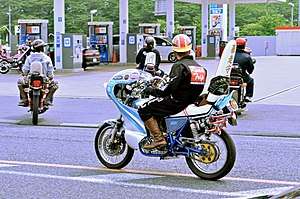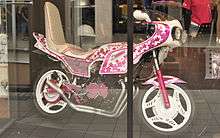Bōsōzoku
Bōsōzoku (暴走族, literally "running-out-of-control (as of a vehicle) tribe") is a Japanese youth subculture associated with customized motorcycles. The first appearance of these types of biker gangs was in the 1950s. Popularity climbed throughout the 1980s and 1990s, peaking at an estimated 42,510 members in 1982. Their numbers dropped dramatically in the 2000s with a reported number of under 7,297 members in 2012.[1]

Bōsōzoku style traditionally involves boilersuits similar to those of manual laborers or leather military jackets with baggy pants, and tall boots. This uniform became known as the tokkō-fuku (特攻服, "special attack clothing") and is often adorned with kanji slogans. Typical accessories to this uniform are hachimaki, surgical masks, and patches displaying the Japanese Imperial Flag. Bōsōzoku members are known for taking a Japanese Road Bike and adding modifications such as over-sized fairings, lifted handle bars shifted inwards, large seat backs, extravagant paint jobs, and modified mufflers. Bōsōzoku styles take inspiration from American choppers and greasers.[2]
Traits and history
The word bōsōzoku is also applied to motorcycle subculture with an interest in motorcycle customizing, often illegal, and making noise by removing the mufflers on their vehicles so that more noise is produced. These bōsōzoku groups sometimes ride without motorcycle helmets (which in Japan is illegal), also engage in dangerous or reckless driving, such as weaving in traffic, and running red lights. Another activity is speeding in city streets, not usually for street racing but more for thrills. With many bikes involved, the leading one is driven by the leader, who is responsible for the event and is not allowed to be overtaken. Japanese police call them Maru-Sō (police code マル走 or 丸走) and occasionally dispatch police vehicles to trail the groups of bikes for the reason of preventing possible incidents, which may include: riding very slowly through suburbs at speeds of 10-15 km/h, creating a loud disturbance while waving imperial Japanese flags, and starting fights that may include weapons (such as wooden swords, metal pipes, baseball bats and Molotov cocktails). These bōsōzoku gang members are generally between 16 and 19 years old.[3]
They were first seen in the 1950s as the Japanese automobile industry expanded rapidly. The precursors to the bōsōzoku were known as kaminari zoku (雷族, "Thunder Tribe"), urban motorcyclists more akin to the British rockers. Many, if not most, bōsōzoku members came from a lower socioeconomic class and may have used the motorcycle gang activities as a way to express disaffection and dissatisfaction with Japanese mainstream society.[3]
In the 1980s and 1990s, bōsōzoku would often embark on massed rides, in which up to 100 bikers would cruise together slowly en masse down an expressway or major highway. The motorcyclists would run toll booths without stopping and would ignore police attempts to detain them. New Year's Eve was a popular occasion for the massed rides. The bikers would sometimes smash the cars and threaten or beat up any motorists or bystanders who got in the way or expressed disapproval of the bikers' behavior. Participation in the gangs peaked at 42,510 members in 1982.[4]
In 2004, the Japanese government passed a revised road traffic law which gave the police more power to arrest bikers riding recklessly in groups. With increased arrests and prosecutions, bōsōzoku participation went into decline. As of 2010, police reported that the new trend among bōsōzoku was to ride together in much smaller groups and to ride scooters instead of heavily modified motorcycles. Aichi Prefecture was reported to have the highest number of riders, followed by Tokyo, Osaka, Ibaraki and Fukuoka.[5]
In February 2011, the Japanese National Police announced that membership in the gangs had fallen to 9,064, the lowest number since the collection of data on the gangs began in 1975. The police put the total number of gangs nationwide at 507, down 76 from 2009.[4] Their number in the Tokyo area had fallen from 5,300 in 1980 to 119 in 2012.[6] In 2013, the National Police Agency re-classified bōsōzoku biker gangs as "pseudo-yakuza" organizations.[7]
Vehicles

Bōsōzoku are known to modify their motorcycles in peculiar and showy ways, which are called Kaizōsha (改造車,"Modified Vehicles"). The general style of bōsōzoku bike modification appears to combine elements of an American chopper bike and a British café racer. Examples of modifications that are taken from these styles are raised handle bars like those on a chopper or over-sized fairings like those found on café racers (though bōsōzoku usually fit them much higher on the bike than their original position, and angled upwards at the front).[3]
A typical customized bōsōzoku bike starts off by taking an average 250-400cc Japanese road bike, adding a shugo exhaust system (multiple tube header), squeezing the handlebars inwards (known as shibori), and adding a 3 or 4-trumpet horn- sanren or yonren, respectively.[3] Loud paint schemes on the fenders or the gas tanks with motifs such as flames or kamikaze-style "rising sun" designs are also quite common. The bikes will often be adorned with stickers and/or flags depicting the gang's symbol or logo.[2]
There are also marked regional differences in motorcycle modifications. For example, Ibaraki bōsōzoku are known to modify their motorcycles in an extensively colorful, flashy way. They will often have three or four oversized fairings in a tower-like way in and an abundance of lights.[8]
In America it is common to hear Kaido Racers referred to as "Bosozoku", though this is not the case. They can often seem similar and can be seen on highways together in Japan, though they are two different things. More extreme "silhouette style" Kaido Racers often take inspiration from old race cars of the 80s. They add wide bodykits and huge wings, resembling the Group 5 "Special Production Cars" of the 1970s.[9]
Stereotypes and media characterizations
The tokkō-fuku is usually worn open with no shirt underneath, exposing their bandaged torsos and baggy, matching pants tucked inside tall boots. Tokkō-fuku in Japanese means "Special Attack Clothing", which is the uniform of the Kamikaze pilots, the Tokkō-tai (特攻隊, "Special Attack Battalion").[10] These tokkō-fuku uniforms are typically adorned with militaristic slogans, patriotic rising sun patches, or ancient Chinese characters. The uniform is often accompanied by a tasuki, a look inspired by Japanese World War II fighter pilots.
Leather jackets embroidered with club/gang logos, and even full leather suits are also seen as common elements of the bōsōzoku look. Other items in the bōsōzoku wardrobe usually include round sunglasses, long hachimaki headbands also with battle slogans and a pompadour hairstyle usually attributed to either the greaser/rocker look or a look that tends to be associated with yakuza thugs. The punch perm hairstyle and Surgical masks are also considered common bōsōzoku attire.
See also
- Mat Rempit
- Ah Beng
- Mod, a youth movement in the United Kingdom, associated with customised scooters
- Outlaw motorcycle club
- Raggare
- Tafheet
Notes
Citations
- Osaki, Tomohiro (18 April 2013). "Documentary chronicles disappearing world of 'bosozoku'". The Japan Times.
- Callahan, Kat. "The Bosozoku Are Japan's Disappearing Rebels Without a Cause". Jalopnik.
- Sato, Ikuya (1986). 'Bosozoki' and Yankee: Anomy and Parody in the Affluent Society (PhD). The University of Chicago. ProQuest 303443061.
- Kyodo News, "Biker gang ranks fall below 10,000", The Japan Times, 11 February 2011, p. 2.
- Chunichi Shimbun, "Aichi biker gangs up but downsized", The Japan Times, July 17, 2010, p. 3.
- Metropolis, "The Small Print: Stats", #942, 13–26 April 2012, p. 4
- "Tokyo cops accuse Chinese Dragon executive in gashing of man with broken bottle". Tokyo Reporter. June 29, 2017.
Law enforcement had long viewed Chinese Dragon, along with Kento Rengo, as bosozoku biker gangs. However, starting in 2013 the National Police Agency began classifying bosozoku gangs as “pseudo-yakuza” groups to better reflect the true state of their activities.
- Writers, Yabai. "Bosozoku: The Craziest Autos in the World". YABAI.
- Carter Jung (2010-05-05). "Nissan Heritage Car Collection (Part 1 of 2)". Import Tuner Magazine. Retrieved 2015-11-18.
- Zaloga, Steven J. (June 21, 2011). Kamikaze: Japanese Special Attack Weapons 1944–45 (1 ed.). Osprey Publishing. p. 12. ISBN 978-1849083539.
Bibliography
- Fujisawa Toru. Shonan Junai Gumi (湘南純愛組!). Shonen Magazine Comics. ISBN 4-06-312257-3
- Greenfeld, Karl Taro. Speed Tribes: Days and Nights with Japan's Next Generation. New York: HarperCollins, 1994. ISBN 0-06-092665-1.
- Sato, Ikuya. Kamikaze Biker: Parody and Anomy in Affluent Japan. Chicago: University of Chicago Press, 1998. ISBN 0-226-73525-7.
- Sasaki, Hiroto, and Tokoro Jewzo. Bukkomi no Taku: Kaze Densetsu (特攻の拓). Shonen Magazine Comics. ISBN 4-06-312449-5.
- Yoshinaga, Masayuki. Bosozoku. London: Trolley Books, 2002. ISBN 0-9542648-3-5.
External links
| Wikimedia Commons has media related to Bōsōzoku. |
- Metropolis magazine, Last of the Speed Tribes (general article about bōsōzoku culture and its decline)
- Vice, Life Inside Japan's Aging Biker Gangs (documentary about current and former bōsōzoku)
- Mookychick, Bosozoku japanese biker gangs and bosozoku style (key elements of bōsōzoku fashion)
- Bosozoku Style (blog showcasing bōsōzoku style cars)